
Mount Foresta is an 11,000+ ft multi-peak massif located in Wrangell–St. Elias National Park, in the Saint Elias Mountains of Alaska in the United States. Rising high above the lower western margin of the Hubbard Glacier, the summit of Mount Foresta is just over nine miles (14 km) from tidewater at Disenchantment Bay, 12 mi (19 km) northwest of Mount Seattle, 14.5 mi (23 km) southeast of Mount Vancouver, and 46 mi (74 km) north of Yakutat.
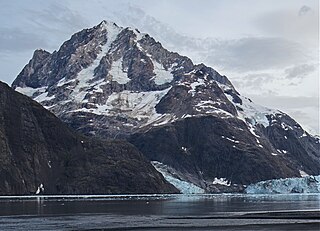
Mount Abbe is an 8200+ feet double summit mountain located in the Fairweather Range of the Saint Elias Mountains, in southeast Alaska. The peak is situated near the terminus of the Johns Hopkins Glacier, within Glacier Bay National Park and Preserve, 100 mi (161 km) northwest of Juneau, and 8.2 mi (13 km) northeast of Mount Orville. Although modest in elevation, relief is significant since the mountain rises up from tidewater in less than two miles. Mount Abbe is often seen and photographed with the Johns Hopkins Glacier, which is a popular destination for cruise ships. The mountain was named in 1936 by William Osgood Field and William Skinner Cooper, of the American Geographical Society, for Cleveland Abbe Jr., (1872-1934), an American geographer. Abbe received a Ph.D. in 1898 from Johns Hopkins University. The Gilman Glacier and Clark Glacier on the mountain's slopes were named for Daniel Coit Gilman, the institution's first president, and William Bullock Clark who was a professor of geology at the university. The mountain's name was officially adopted in 1937 by the United States Geological Survey. The first ascent of the south summit was made June 11, 1977, by Jim Wickwire and Dusan Jagersky via the Southeast Face. Three days later, Dusan Jagersky was killed while descending an unnamed peak. The first ascent of the north summit was made July 14, 1991, by Walter Gove and William Pilling. The months May through June offer the most favorable weather for climbing Mount Abbe, but it's a challenging climb in any conditions, with few attempts.

Mount Tom White is a prominent 11,191-foot glaciated mountain summit located in the Chugach Mountains, in the U.S. state of Alaska. The remote peak is situated on land managed by Chugach National Forest, 72 mi (116 km) northeast of Cordova, and 20 mi (32 km) north of the Bering Glacier, North America's largest glacier. The mountain lies within the Copper River drainage basin, and is the eighth-highest major peak in the Chugach Mountains. Topographic relief is significant as it ranks 17th in prominence for all peaks in Alaska, and 52nd for all North America peaks. The first ascent of the mountain was made in 1973 by Story Clark, Chris Hall, Tom Kizzia, William Resor, Sarah Robey, and Don White.

Mount Huxley is a 12,216-foot glaciated mountain summit located in the Saint Elias Mountains of Wrangell-St. Elias National Park and Preserve, in the U.S. state of Alaska. The remote peak is situated 75 mi (121 km) northwest of Yakutat, and 8.7 mi (14 km) west-northwest of Mount Saint Elias. The peak rises above the Columbus Glacier and Bagley Icefield to its north, the Tyndall Glacier to the south, and the Yahtse Glacier to the west. Precipitation runoff from the mountain drains into the Gulf of Alaska. The mountain was named in 1886 by English mountaineer Harold Ward Topham for Thomas Henry Huxley (1825-1895), an English biologist. The mountain was officially named Huxley Peak in 1917, but the name was officially changed to Mount Huxley in 1968 by the U.S. Board on Geographic Names. The first ascent of the peak was made June 9, 1996 by Paul Claus who landed his plane at 11,500 feet elevation on the western flank and climbed the remaining distance to the summit. The second ascent of Mt. Huxley, and first complete ascent from base to summit, was made in June 2018 by Scott Peters, Andrew Peter, and Ben Iwrey starting from the Columbus Glacier.

Mount Chitina is an 8,424-foot (2,568-meter) mountain summit located in the Saint Elias Mountains of Wrangell-St. Elias National Park and Preserve, in the U.S. state of Alaska. The remote peak is situated 113 mi (182 km) northwest of Yakutat, and 40 mi (64 km) northwest of Mount Logan. Mount Chitina rises 5,000+ ft above the confluence of the Chitina Glacier and the Logan Glacier. Precipitation runoff from the mountain drains into the Chitina River, which in turn is part of the Copper River drainage basin. The first ascent of the peak was made September 24, 1988, by Danny Kost and Donnie Hunton via the west ridge. The mountain's name is derived from the Chitina Glacier located at the base of the north slope, and was first published on a Canadian topographic map in 1958.
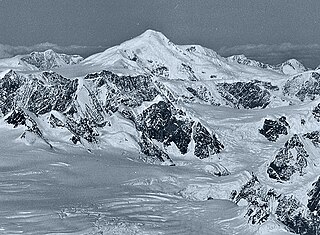
Mount Einstein is an 11,552-foot (3,521 m) elevation glaciated summit located 32 mi (51 km) northwest of Valdez in the Chugach Mountains of the U.S. state of Alaska. This remote mountain, sixth-highest in the Chugach range, is situated at the head of Yale Glacier on land managed by Chugach National Forest. The mountain was named in 1955 by members of the Chugach Mountains Expedition, and officially adopted by the United States Geological Survey to honor physicist Dr. Albert Einstein (1879–1955), considered one of the greatest scientists of all time, known for his Theory of relativity. The first ascent of Mt. Einstein was made June 17, 1957, by David Bohn, Arthur Maki, Jr., Don Mokski, Martin Mushkin, and Lawrence E. Nielsen.
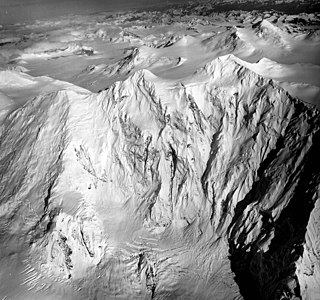
Mount Witherspoon is a 12,012-foot-elevation glaciated summit located 36 mi (58 km) northwest of Valdez in the Chugach Mountains of the U.S. state of Alaska. It's set on land managed by Chugach National Forest. This remote mountain, fifth-highest in the Chugach range, is situated 4.33 mi (7 km) northwest of Mount Einstein, with the heads of Yale Glacier and Columbia Glacier between the summits. It is the second-highest peak in the Dora Keen Range, which is the 25-miles-long divide separating Harvard Glacier from Yale Glacier. The mountain's name was officially adopted in 1928 by the U.S. Board on Geographic Names to honor David C. Witherspoon, a U.S. Geological Survey topographer for 30 years, "who at the time of his retirement in 1921 had mapped a greater area of Alaska than any other man." The first ascent of Mount Witherspoon was made June 25, 1957, by David Bohn, Arthur Maki, Jr., Martin Mushkin, and Lawrence E. Nielsen.
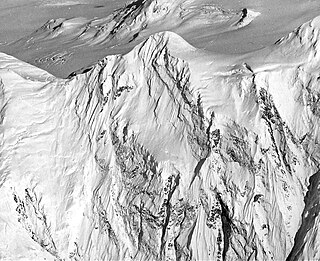
Mount Edison is an 11,450-foot (3,490 m) elevation glaciated summit located 36 mi (58 km) northwest of Valdez in the Chugach Mountains of the U.S. state of Alaska. Set on land managed by Chugach National Forest, this remote peak is situated 4.7 mi (8 km) northwest of Mount Einstein, near the head Columbia Glacier. It is part of the Dora Keen Range, which is a 25-miles-long divide separating Harvard Glacier from Yale Glacier. The mountain was named by members of the Chugach Mountains Expedition in 1955, and later officially adopted by the U.S. Board on Geographic Names to honor Thomas Edison (1847–1931), who has been described as America's greatest inventor.
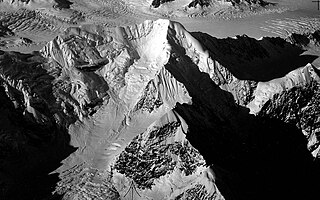
Mount Defiant is an 8,348-foot (2,544 m) elevation glaciated summit located 32 mi (51 km) northwest of Valdez in the Chugach Mountains of the U.S. state of Alaska. This remote mountain is situated 2.5 mi (4 km) east-northeast of Columbia Peak, 6.5 mi (10 km) south of Mount Einstein, near the head of Columbia Glacier's Second Branch, on land managed by Chugach National Forest. Mount Defiant was named in 1957 by members of the Chugach Mountains Expedition which was sponsored by the Arctic Institute of North America, because the rugged ice-covered peak defied all their attempts to find a route to the summit. The mountain's name was officially adopted in 1965 by the U.S. Board on Geographic Names.
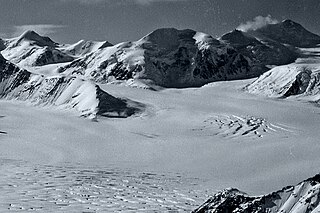
Mount Elusive is an 11,465-foot (3,495 m) elevation glaciated summit located 36 mi (58 km) northwest of Valdez in the Chugach Mountains of the U.S. state of Alaska. Set on land managed by Chugach National Forest, this remote peak is situated 3 mi (5 km) northeast of Mount Edison, 3 mi (5 km) southwest of Mount Valhalla, and 4.8 mi (8 km) north of Mount Einstein, near the head Columbia Glacier. It is part of the Dora Keen Range, which is a 25-miles-long divide separating Harvard Glacier from Yale Glacier. The mountain was so named in 1957 by Lawrence E. Nielsen because of the peak's "elusive character in trying to locate its position on the map from aerial photos," and later officially adopted by the U.S. Board on Geographic Names in 1965. Nielsen was leader of the Chugach Mountains Expedition which was sponsored by the Arctic Institute of North America. The first ascent of this mountain was made June 22, 1957, by Nielsen and expedition party via the south ridge. He described the most distinguishing feature of this snow-covered mountain as being a spectacular north–south knife-edge summit ridge.

Benign Peak is a 7,235 ft (2,210 m) elevation mountain summit located in the western Chugach Mountains, in Anchorage Municipality in the U.S. state of Alaska. The mountain is situated in Chugach State Park, 28 mi (45 km) east of Anchorage, and 4.5 mi (7 km) south of Eklutna Lake. The nearest higher peak is Mount Rumble, 2.2 mi (4 km) to the southwest, and The Mitre is set 2.4 mi (4 km) east-southeast, on the opposite side of the Eklutna Glacier. Although modest in elevation, relief is significant since the eastern aspect of the mountain rises over 5,000 feet above this glacier in approximately one mile. This peak belongs to a group of peaks in the Eklutna River drainage which start with the letter "B", such as Bold Peak, Bashful Peak, Baleful Peak, and Mt. Beelzebub. Benign Peak was so named in 1965 by the Mountaineering Club of Alaska because "nearby Bellicose Peak was a much harder climb, while this one's nature was quite benign since the rock was not too rotten and the weather wasn't too bad." Benign Peak's name was officially adopted in 1966 by the U.S. Board on Geographic Names. The first ascent of this mountain was made in August 1965 by Art Davidson and John Vincent Hoeman by ascending the East Face, and descending the South Gully.

Mount Shouplina is an 8,531-foot-elevation (2,600-meter) mountain summit located 18 miles (29 km) north-northwest of Valdez in the U.S. state of Alaska. This remote glaciated mountain is set in the Chugach Mountains on land managed by Chugach National Forest. Precipitation runoff from the mountain drains south to Prince William Sound and north to Tazlina Lake → Tazlina River → Copper River. Topographic relief is significant as the summit rises 2,100 feet (640 m) above the East Branch Columbia Glacier in 0.4 mile (0.64 km). The first ascent of the summit was made in 1985 by John Weiland, Matt Kinney, and Bob Shelton. The mountain was named in 1959 by mountaineer Lawrence E. Nielsen and the toponym was officially adopted in 1965 by the U.S. Board on Geographic Names. The word "Shouplina" is a portmanteau blending the names of the Shoup Glacier and Tazlina Glacier which flow from this mountain's south and north slopes respectively.
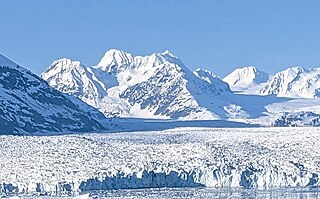
Lindita Peak is a 7,910-foot-elevation (2,411-meter) mountain summit located 17 miles (27 km) north-northwest of Valdez in the U.S. state of Alaska. Lindita is the highest peak at the head of the Tazlina Glacier when viewed from the Glenn Highway at Mile 156 near the Tazlina Glacier Lodge. This remote glaciated mountain is set in the Chugach Mountains on land managed by Chugach National Forest. Precipitation runoff from the mountain drains south to Prince William Sound and north to Tazlina Lake → Tazlina River → Copper River. Topographic relief is significant as the summit rises 2,400 feet (732 m) above the East Branch of the Columbia Glacier in 0.4 mile (0.64 km). The mountain's name Lindita, meaning "little beauty" in Spanish, was applied in 1955 by mountaineer and glaciologist Lawrence E. Nielsen (1917–1992), and the toponym was officially adopted in 1965 by the U.S. Board on Geographic Names. The first ascent of the summit was made on July 1, 1977, by Lawrence E. Nielsen, Halford Joiner, Tom Lamb, and Dr. Randall Travis via the northeast face and the north-facing knife-edged ridge from the Tazlina Glacier.

Mount Allen is a 9,512-foot-elevation (2,899-meter) mountain summit in Alaska, United States.
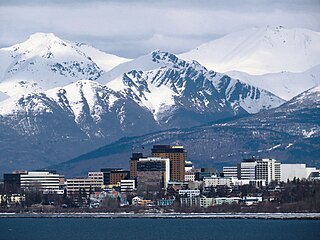
Mount Magnificent is a 4,271-foot (1,302 m) mountain summit in Alaska, United States.

Bellicose Peak is a 7,640-foot (2,329 m) mountain summit in Alaska, United States.

Mount Yukla is a 7,569-foot (2,307 m) mountain summit in Alaska, United States.

Haydon Peak is an 11,924-foot-elevation (3,634-meter) mountain summit in Alaska, United States.
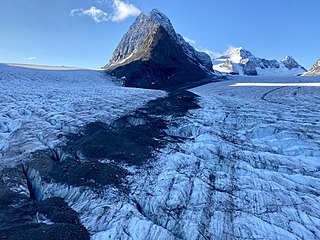
Peril Peak is a 7,040-foot (2,146 m) mountain summit in Alaska, United States.

Whiteout Peak is a 7,135-foot (2,175 m) mountain summit in the U.S. state of Alaska.





















